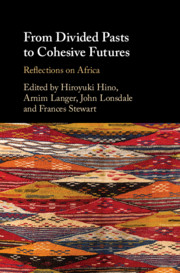Book contents
- From Divided Pasts to Cohesive Futures
- From Divided Pasts to Cohesive Futures
- Copyright page
- Contents
- Figures
- Tables
- Contributors
- Foreword
- Acknowledgments
- Introduction: Understanding Processes of Change in Social Cohesion: Learning from Comparative History
- Part I Social Cohesion in Africa: Case Studies of Past and Present
- Part II Policies and Institutions for Social Cohesion
- Part III Conclusions and Policy Recommendations
- Index
- References
Part II - Policies and Institutions for Social Cohesion
Published online by Cambridge University Press: 05 August 2019
- From Divided Pasts to Cohesive Futures
- From Divided Pasts to Cohesive Futures
- Copyright page
- Contents
- Figures
- Tables
- Contributors
- Foreword
- Acknowledgments
- Introduction: Understanding Processes of Change in Social Cohesion: Learning from Comparative History
- Part I Social Cohesion in Africa: Case Studies of Past and Present
- Part II Policies and Institutions for Social Cohesion
- Part III Conclusions and Policy Recommendations
- Index
- References
Summary
This chapter considers whether there is a trade-off between growth and equality, as economists sometimes assert, differentiating between vertical inequality (among individuals) and horizontal inequality (among groups). Most evidence challenges the supposed trade-off, suggesting greater equality increases growth, especially sustained growth. Inequality among individuals tends to limit human resources, while inequality among groups can lead to violent conflict, and both constrain growth. Greater equality also supports other desirable objectives, including better nutrition, less crime, and better health. The impact of growth on equality is analysed. This depends on how far earnings are spread via employment; and the redistributionary effects of tax and government expenditure. Labour-intensive activities tend to improve distribution, while capital-intensive ones, heavy reliance on minerals for exports and rising skill requirements tend to worsen it. For horizontal inequality, the impact of growth varies according to group location, economic specialization and policies, illustrated by the experience of Ghana, Peru, Malaysia and Northern Ireland. The chapter surveys policies likely to improve vertical and horizontal distribution, with examples drawn from many countries. Finally, the chapter considers the political conditions needed to support equalising policies.
Keywords
- Type
- Chapter
- Information
- From Divided Pasts to Cohesive FuturesReflections on Africa, pp. 191 - 400Publisher: Cambridge University PressPrint publication year: 2019
References
References
References
References
References
References
References
References
- 1
- Cited by

